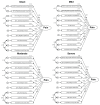Behavioral cues to expand a pain model of the cognitively impaired elderly in long-term care
- PMID: 22807630
- PMCID: PMC3396050
- DOI: 10.2147/CIA.S29656
Behavioral cues to expand a pain model of the cognitively impaired elderly in long-term care
Abstract
Background: The purpose of this study was to determine the relationship between hypothesized pain behaviors in the elderly and a measurement model of pain derived from the Minimum Data Set-Resident Assessment Instrument (MDS-RAI) 2.0 items.
Methods: This work included a longitudinal cohort recruited from Medicare-certified longterm care facilities across the United States. MDS data were collected from 52,996 residents (mean age 83.7 years). Structural equation modeling was used to build a measurement model of pain to test correlations between indicators and the fit of the model by cognitive status. The model evaluates the theoretical constructs of pain to improve how pain is assessed and detected within cognitive levels.
Results: Using pain frequency and intensity as the only indicators of pain, the overall prevalence of pain was 31.2%; however, analysis by cognitive status showed that 47.7% of the intact group was in pain, while only 18.2% of the severely, 29.4% of the moderately, and 39.6% of the mildly cognitively impaired groups were experiencing pain. This finding supports previous research indicating that pain is potentially under-reported in severely cognitively impaired elderly nursing home residents. With adjustments to the measurement model, a revised format containing affective, behavioral, and inferred pain indicates a better fit of the data to include these domains, as a more complete measure of the pain construct.
Conclusion: Pain has a significant effect on quality of life and long-term health outcomes in nursing home residents. Patients most at risk are those with mild to severe cognitive decline, or those unable to report pain verbally. Nursing homes are under great scrutiny to maintain standards of care and provide uniform high-quality care outcomes. Existing data from federally required resident surveys can serve as a valuable tool to identify indicators of pain and trends in care. Great responsibility lies in ensuring pain is included and monitored as a quality measure in long-term care, especially for residents unable to communicate their pain verbally.
Keywords: cognitive impairment; minimum data set; pain behaviors; structural equation modeling; theoretical model.
Figures
References
-
- Epps CD. Recognizing pain in the institutionalized elder with dementia. Geriatr Nurs. 2001;22:71–79. - PubMed
-
- American Health Care Association. OSCAR data reports: Patient characteristics. [Accessed April 15, 2006]. Available at: http://www.ahca.org/research/oscar_patient.htm.
-
- Lowe S. Census Bureau releases new data on residents of adult correctional facilities, nursing homes and other group quarters annual data also pain diverse portrait of nation’s race, ethnic and ancestry group. [Accessed November 27, 2007]. Available at: http://www.census.gov/Press-Release/www/releases/archives/american_commu....
-
- Sawyer P, Lillis JP, Bodner EV, Allman R. Substantial daily pain among nursing home residents. J Am Med Dir Assoc. 2007;8:158–165. - PubMed
-
- Frondini C, Landfranchia G, Minardi M, Cucinotta D. Affective, behavior and cognitive disorders in the elderly with chronic musculoskeletal pain: the impact on an aging population. Arch Gerontol Geriatr. 2007;44:167–171. - PubMed
Publication types
MeSH terms
LinkOut - more resources
Full Text Sources
Medical
Research Materials
Miscellaneous






